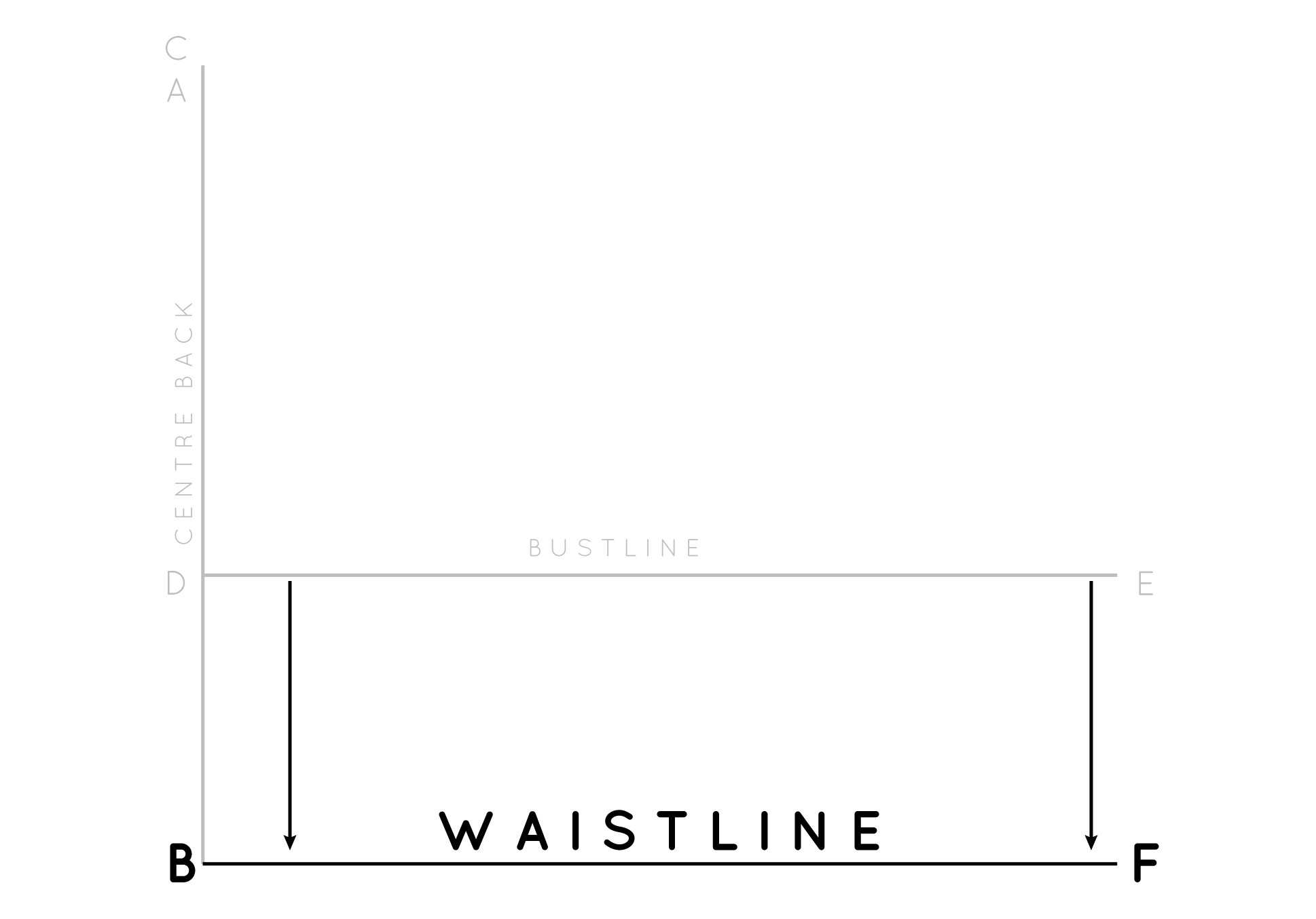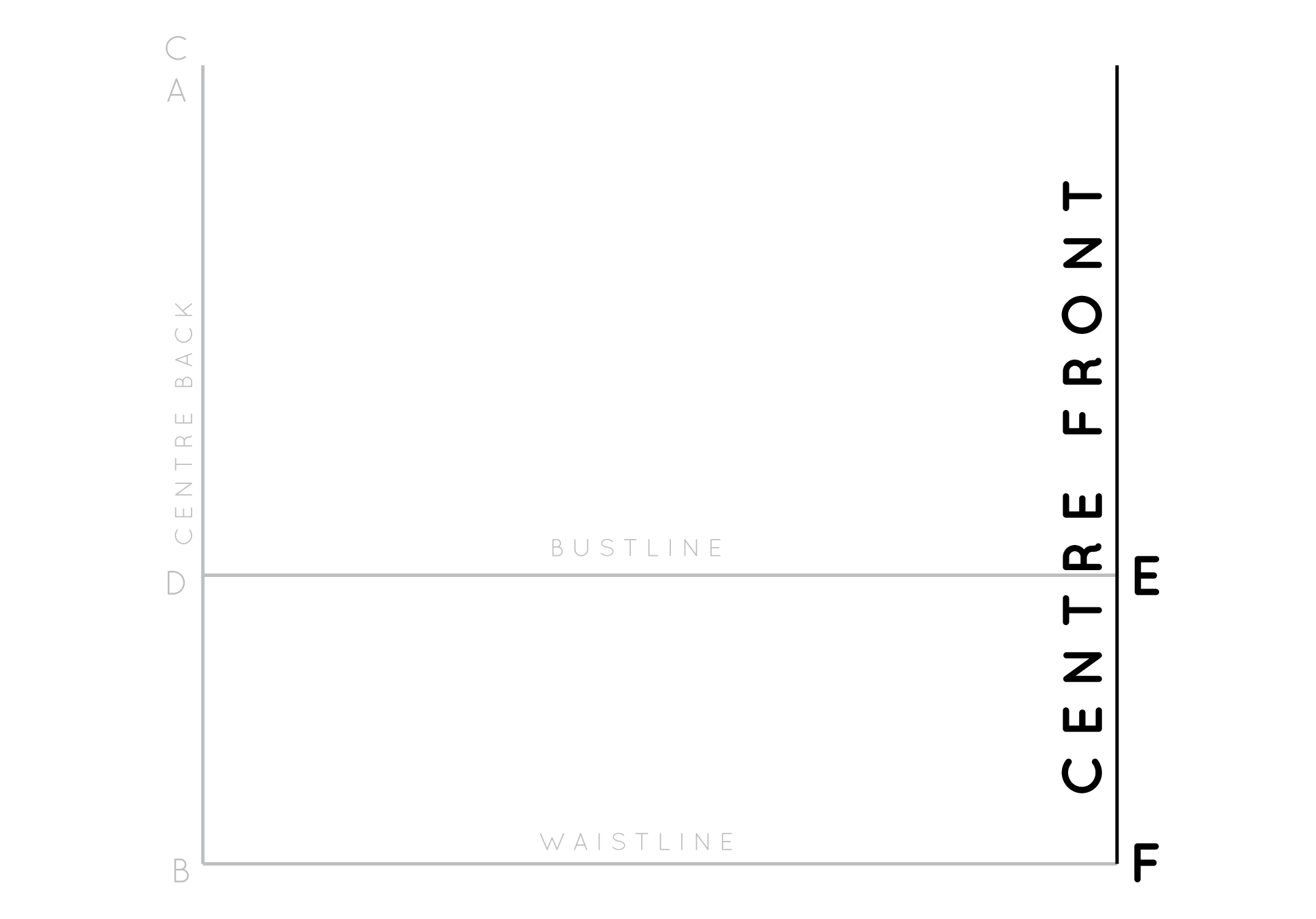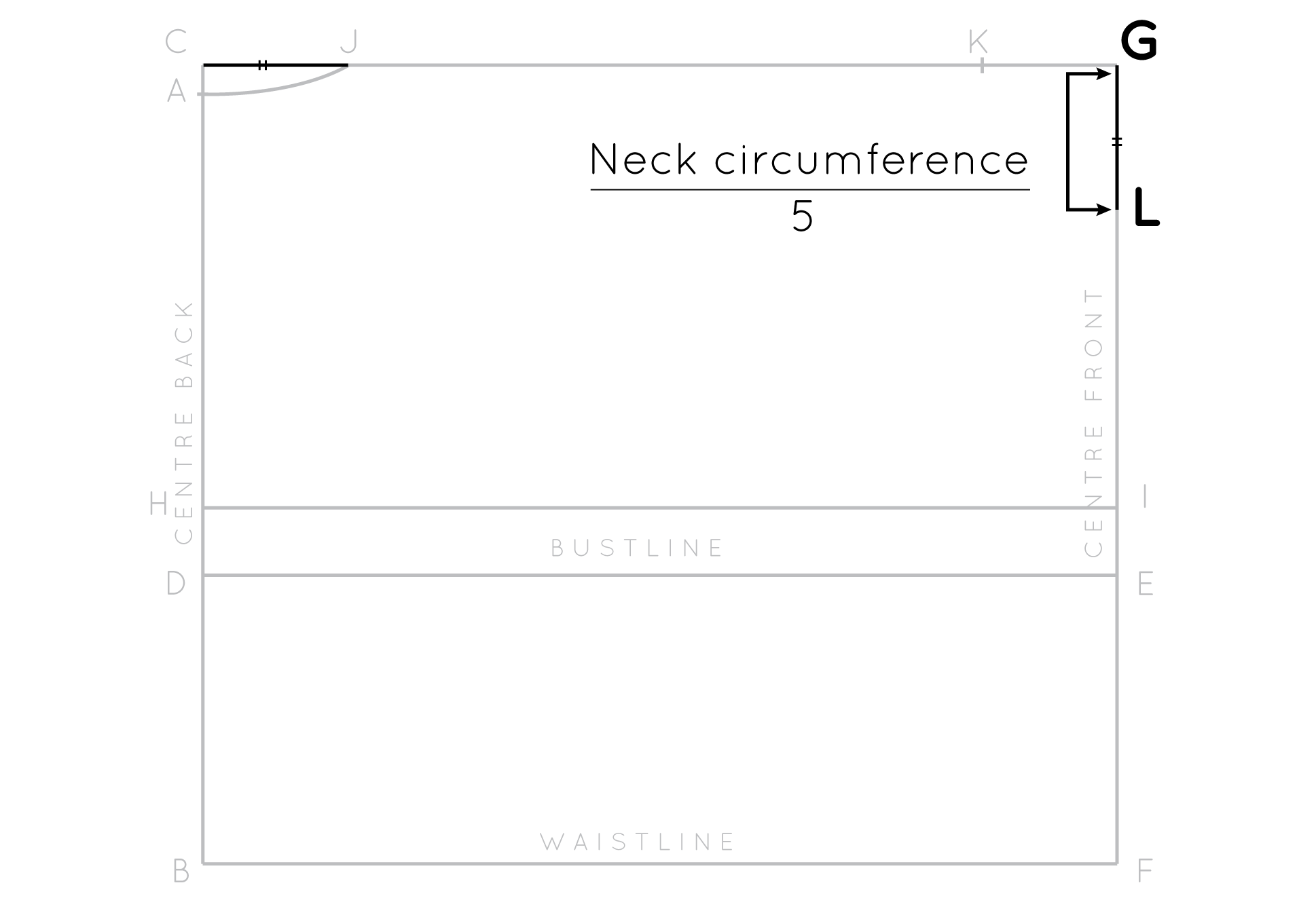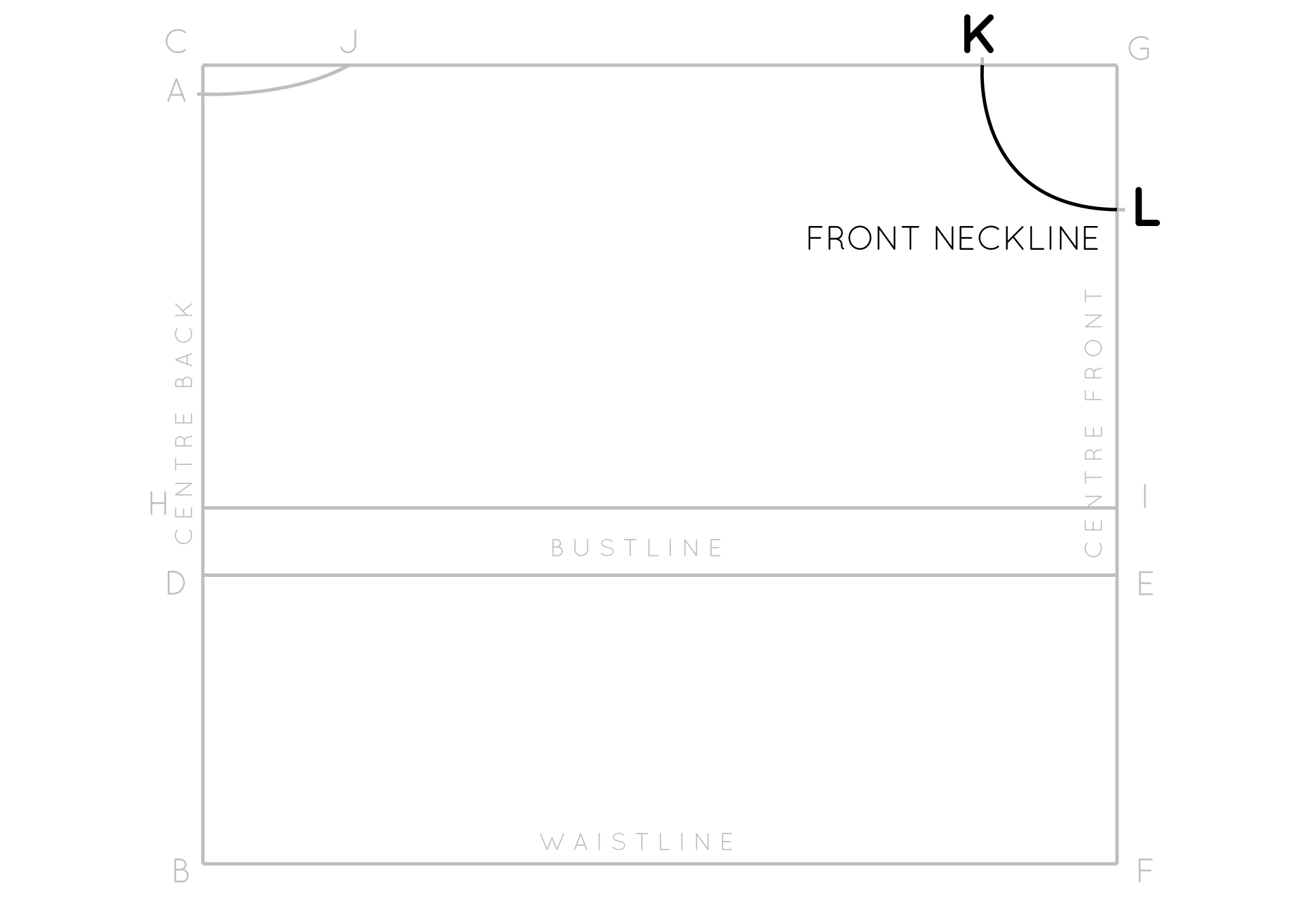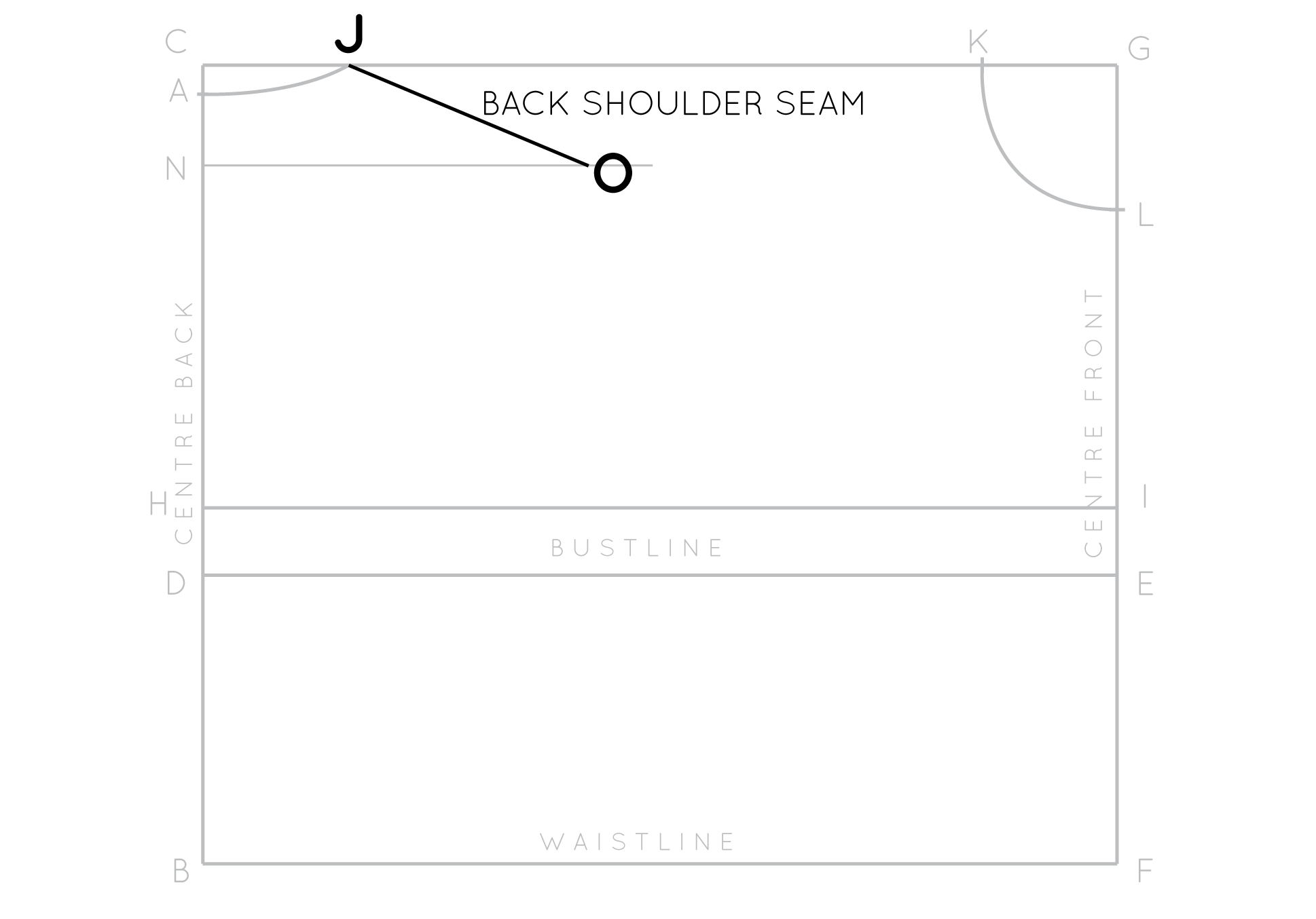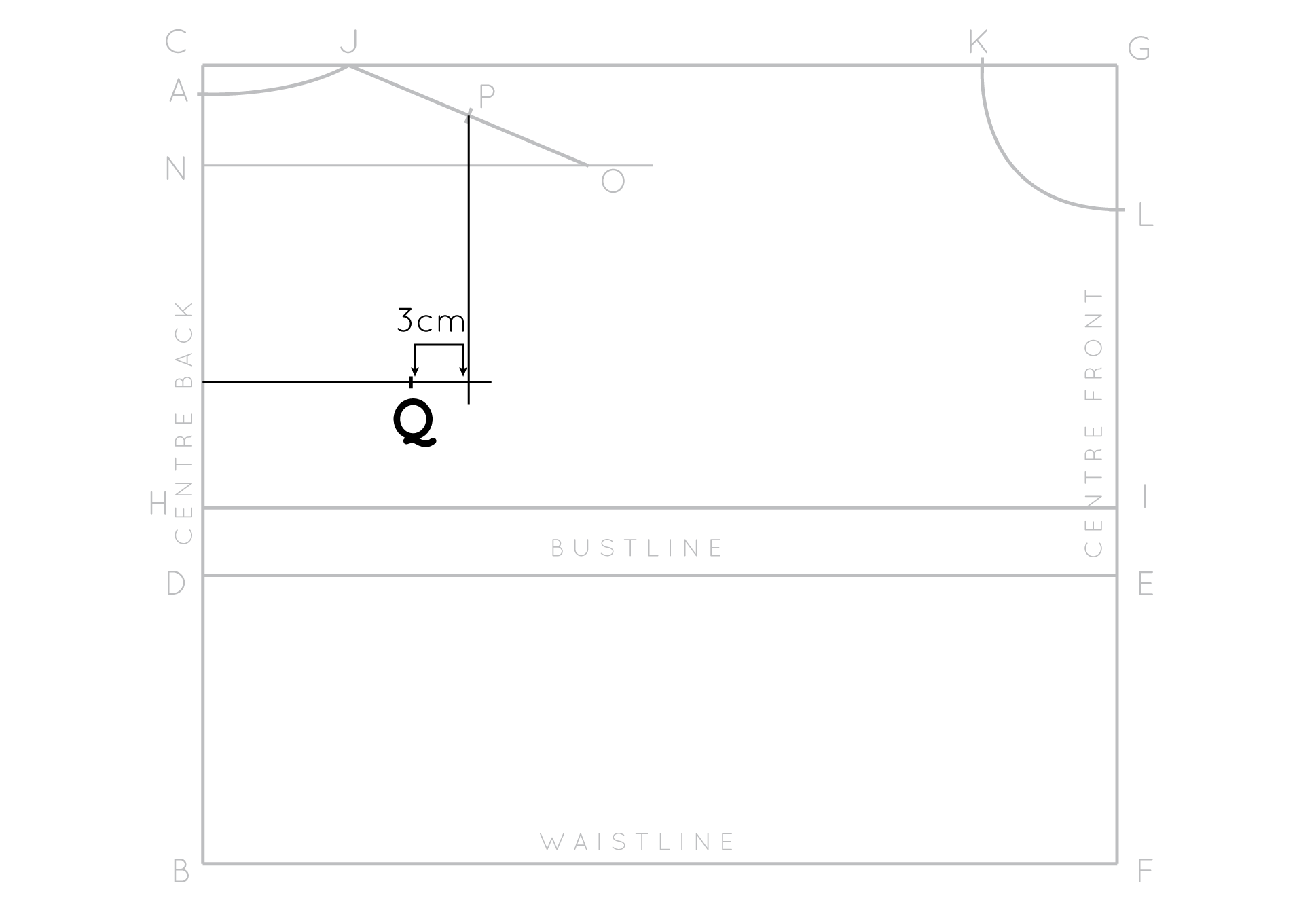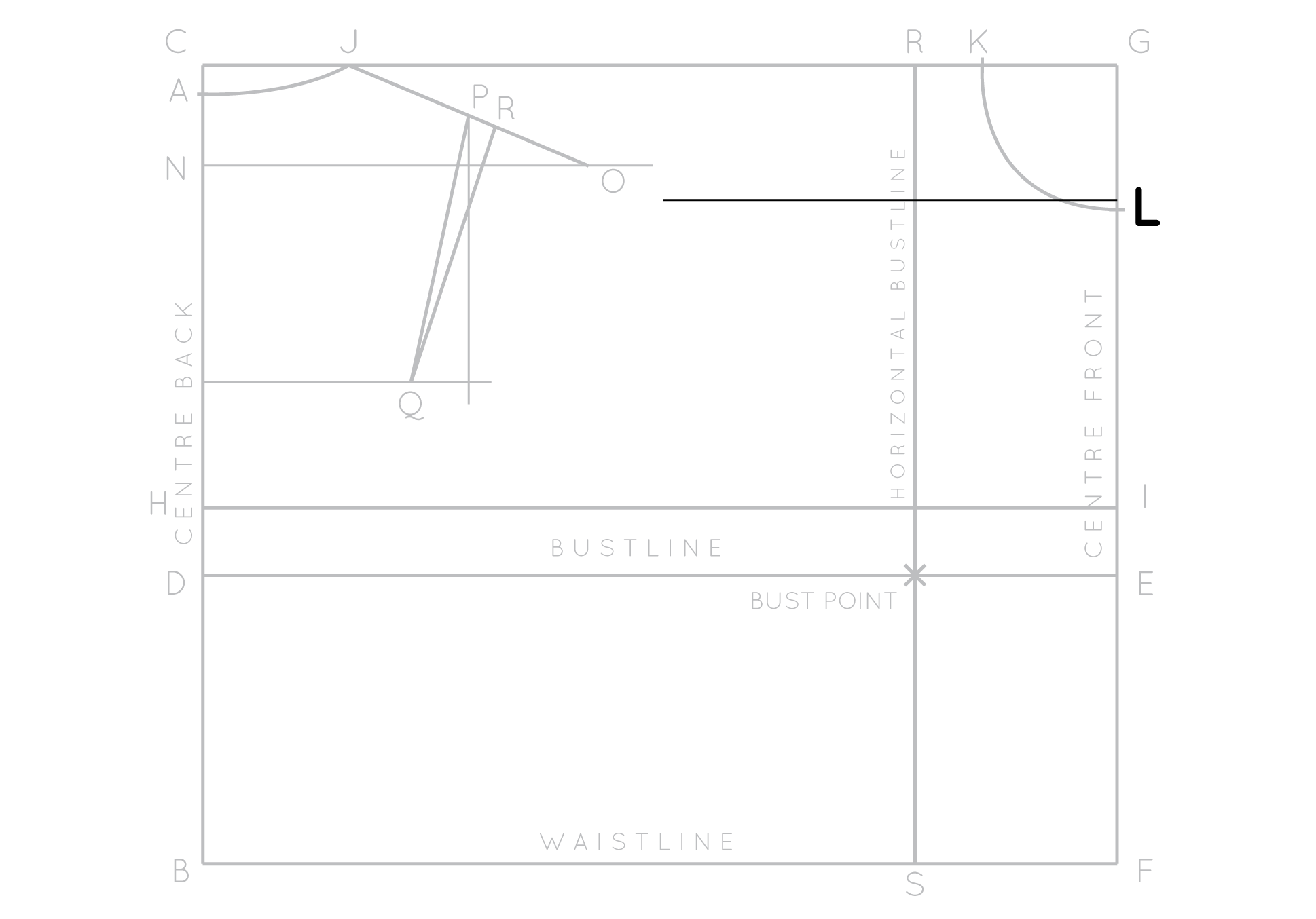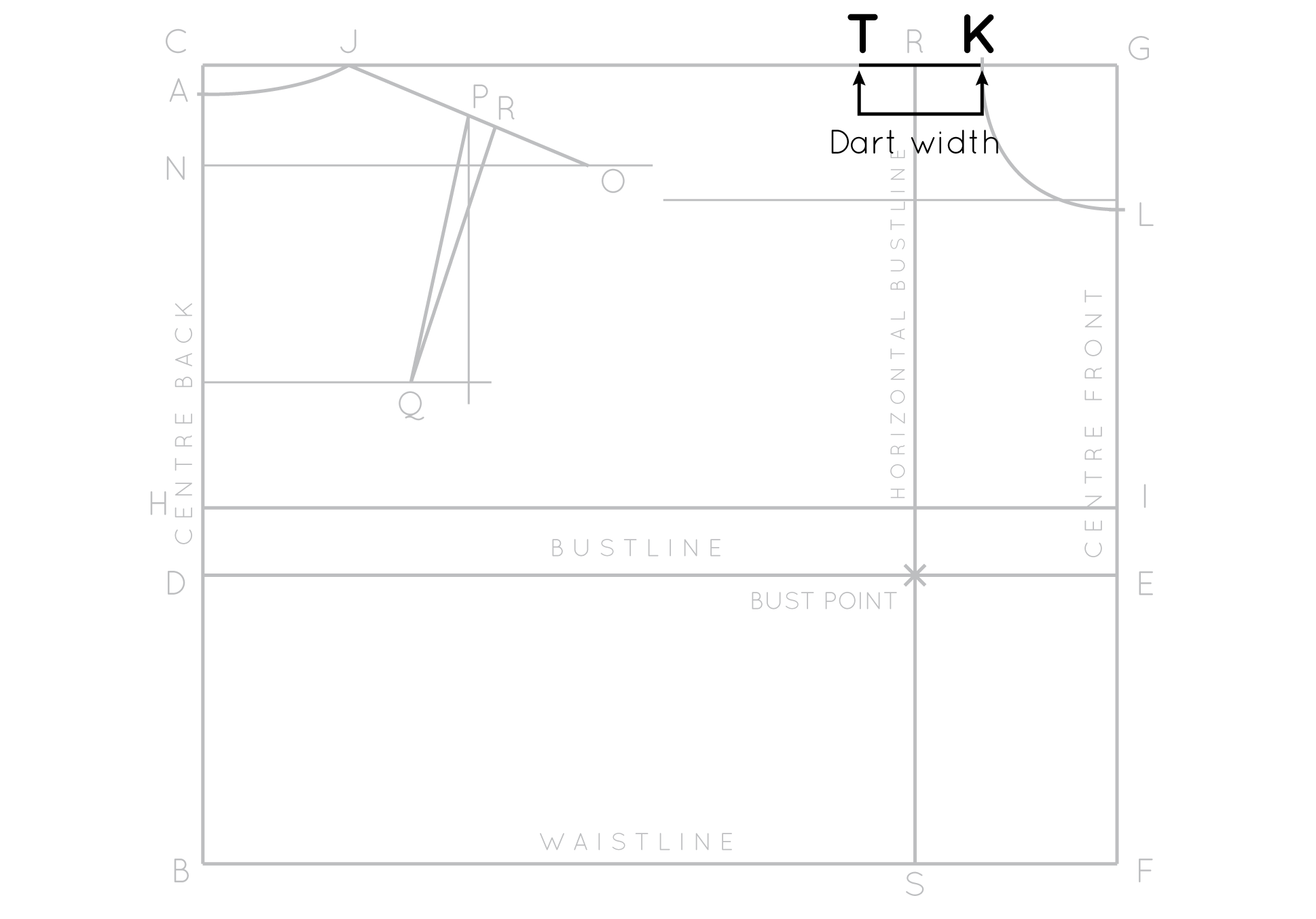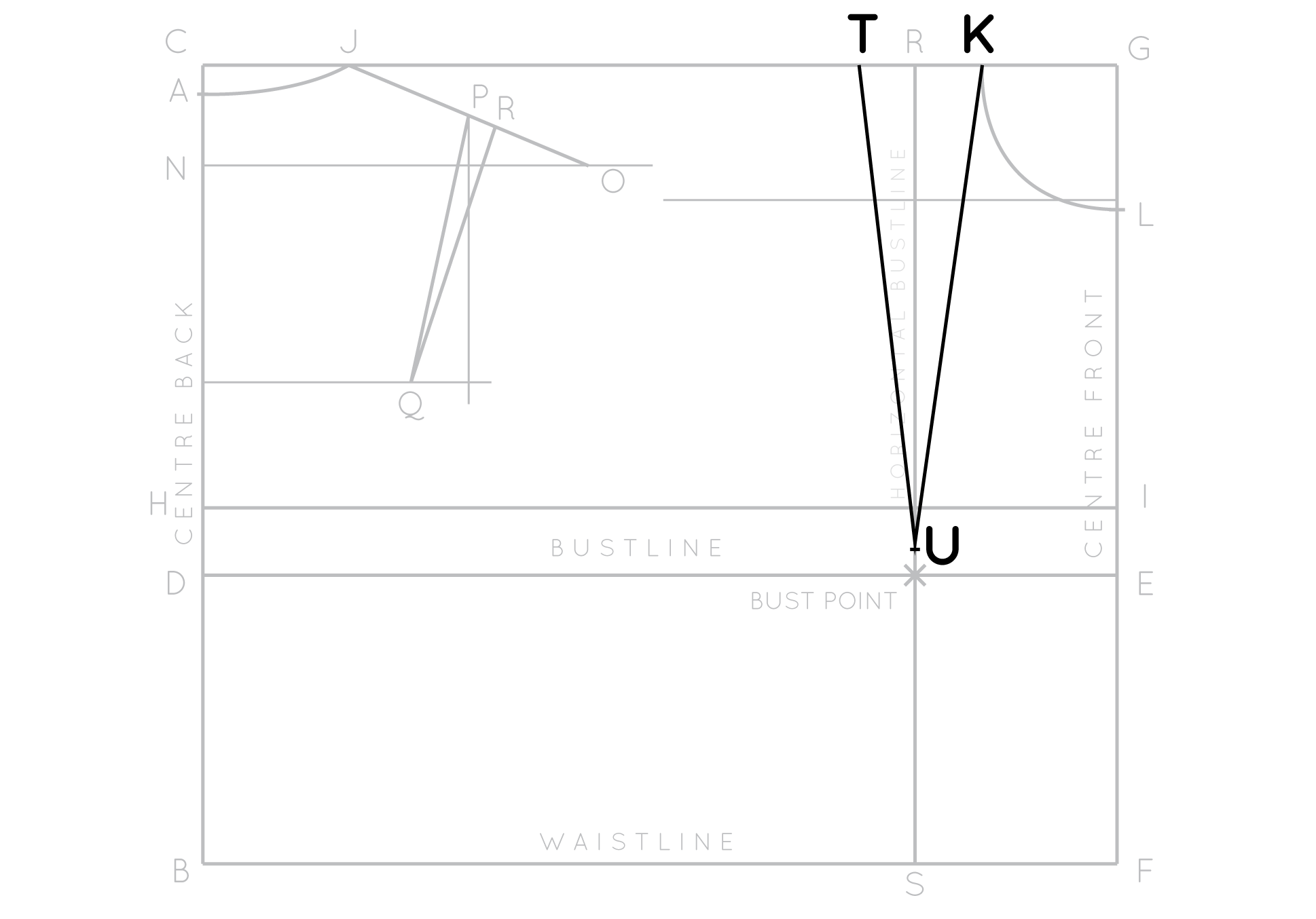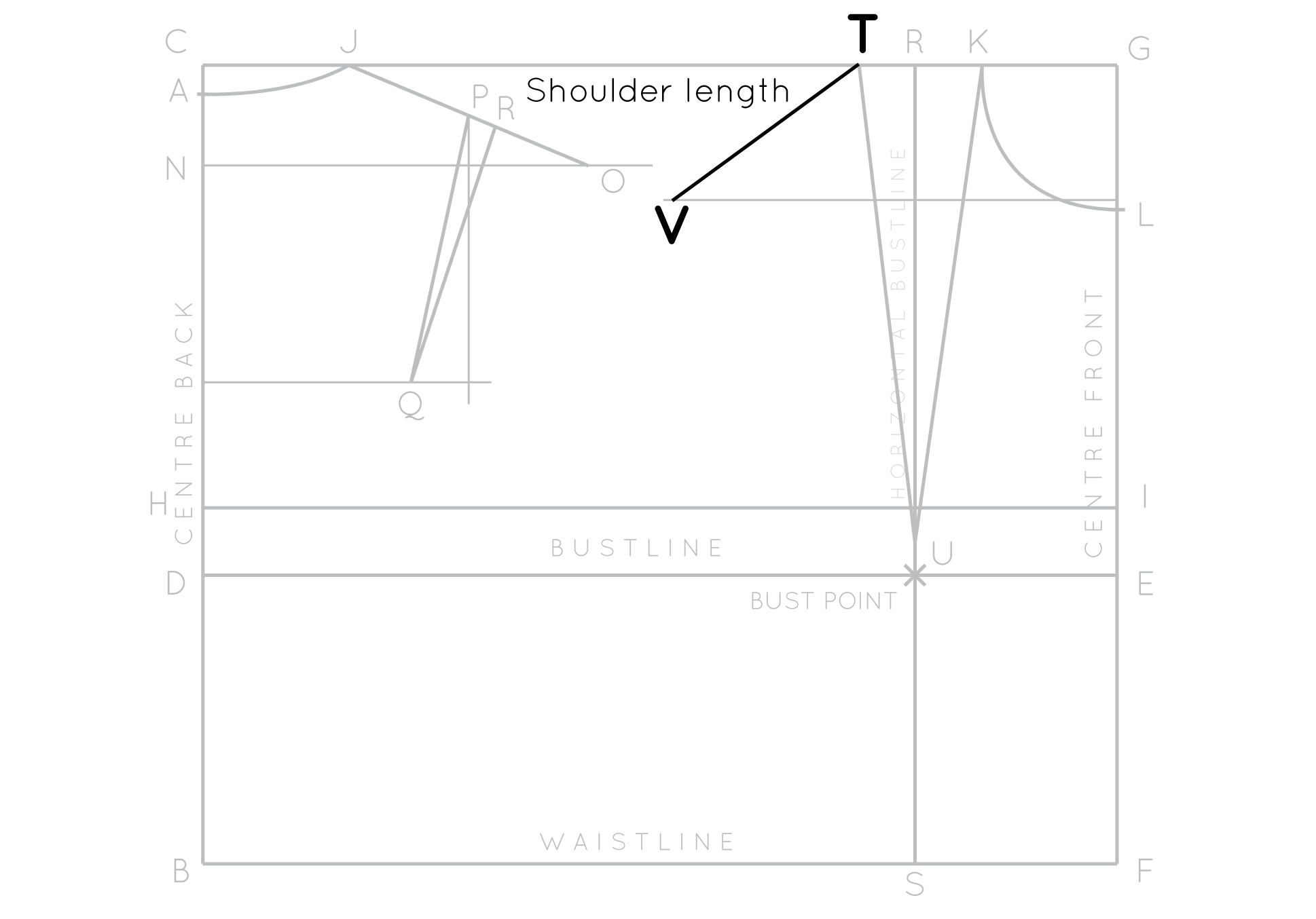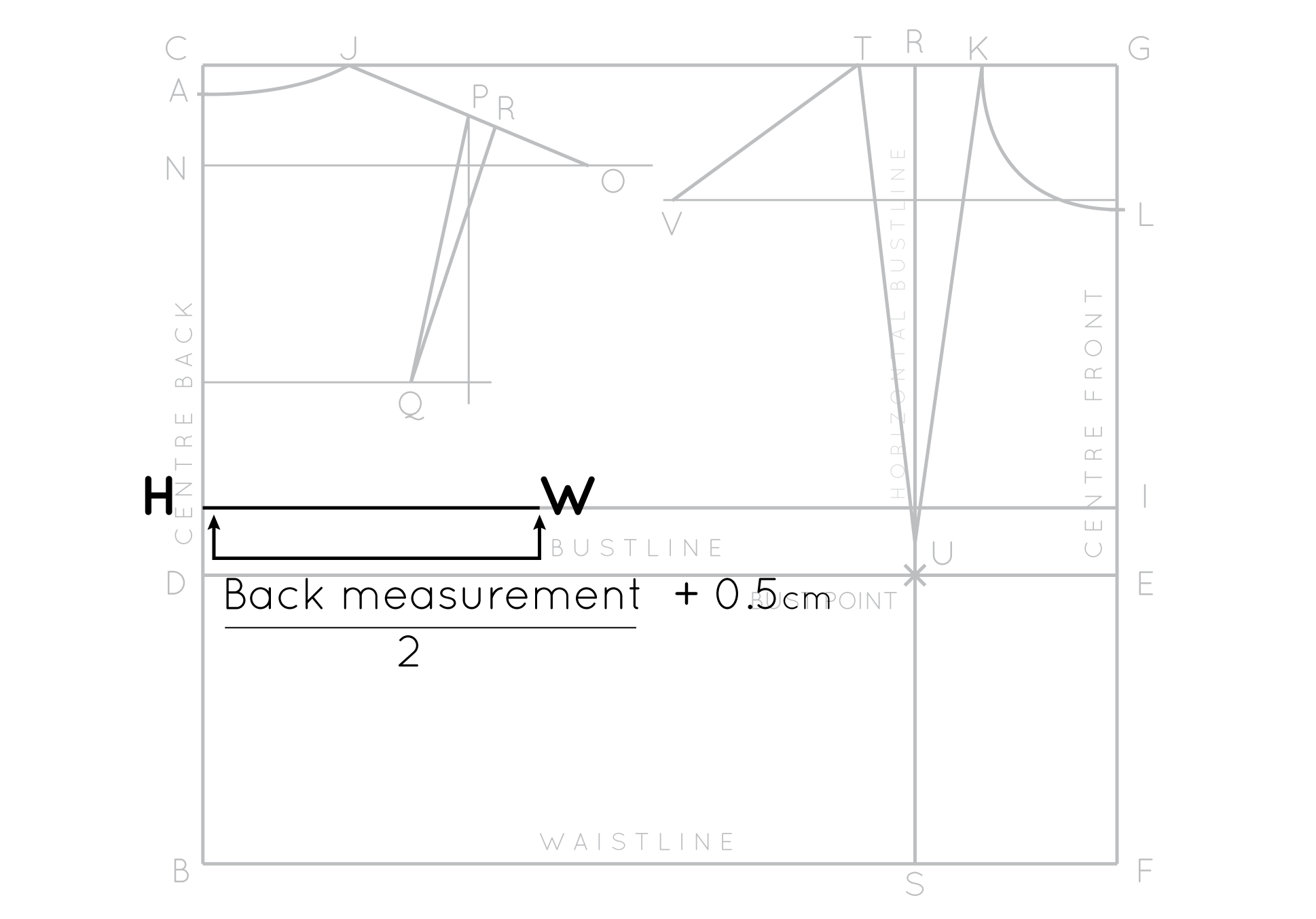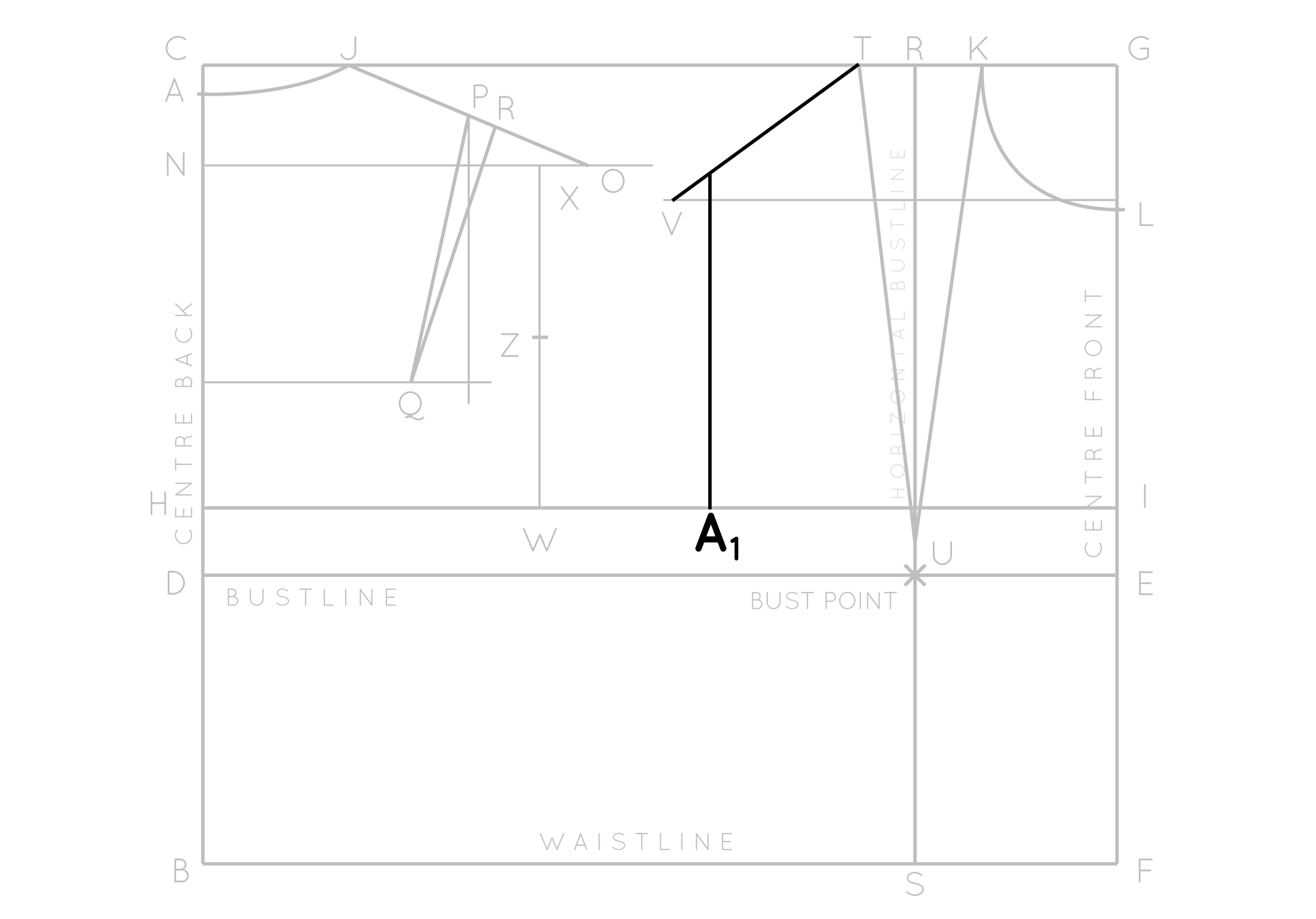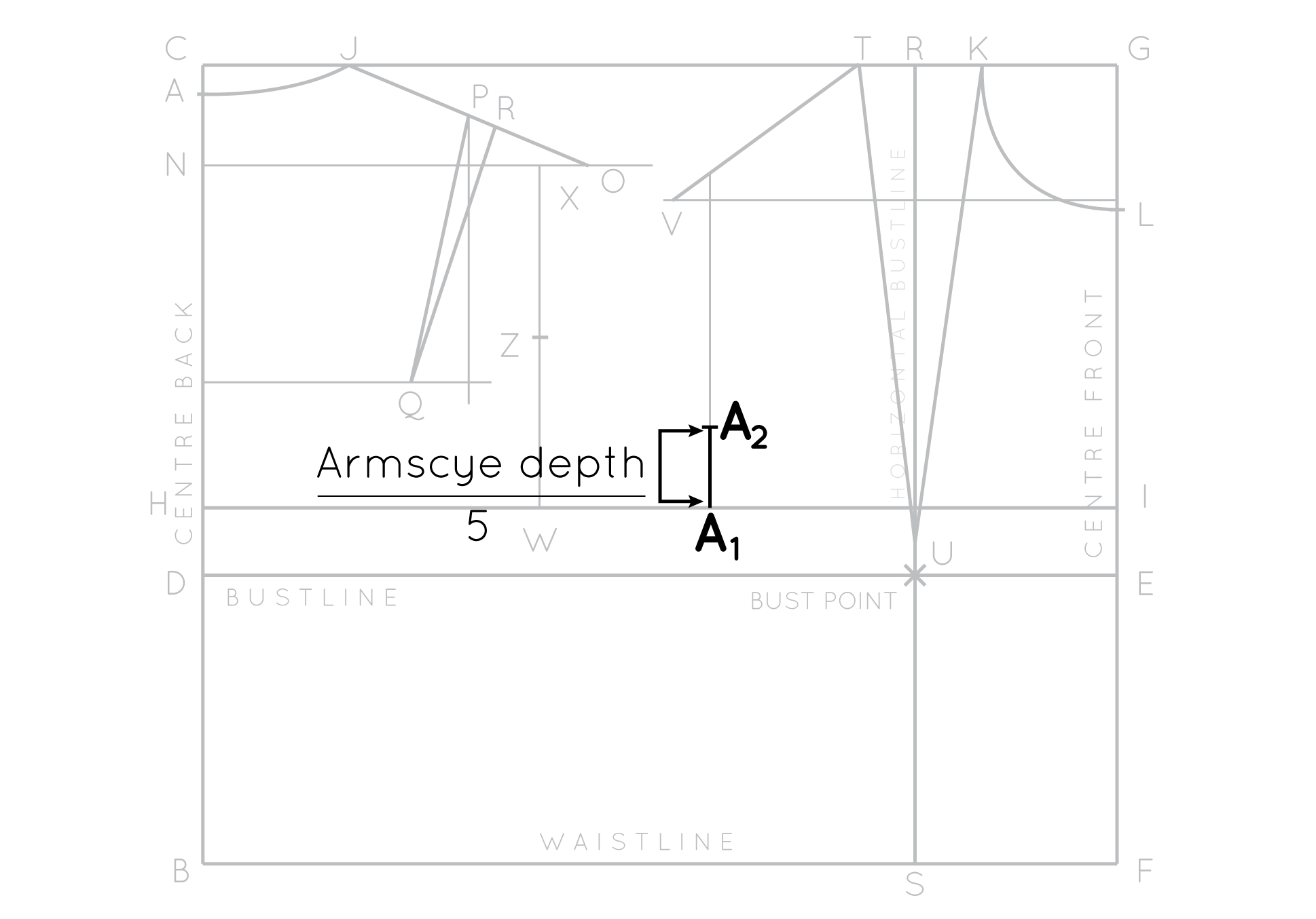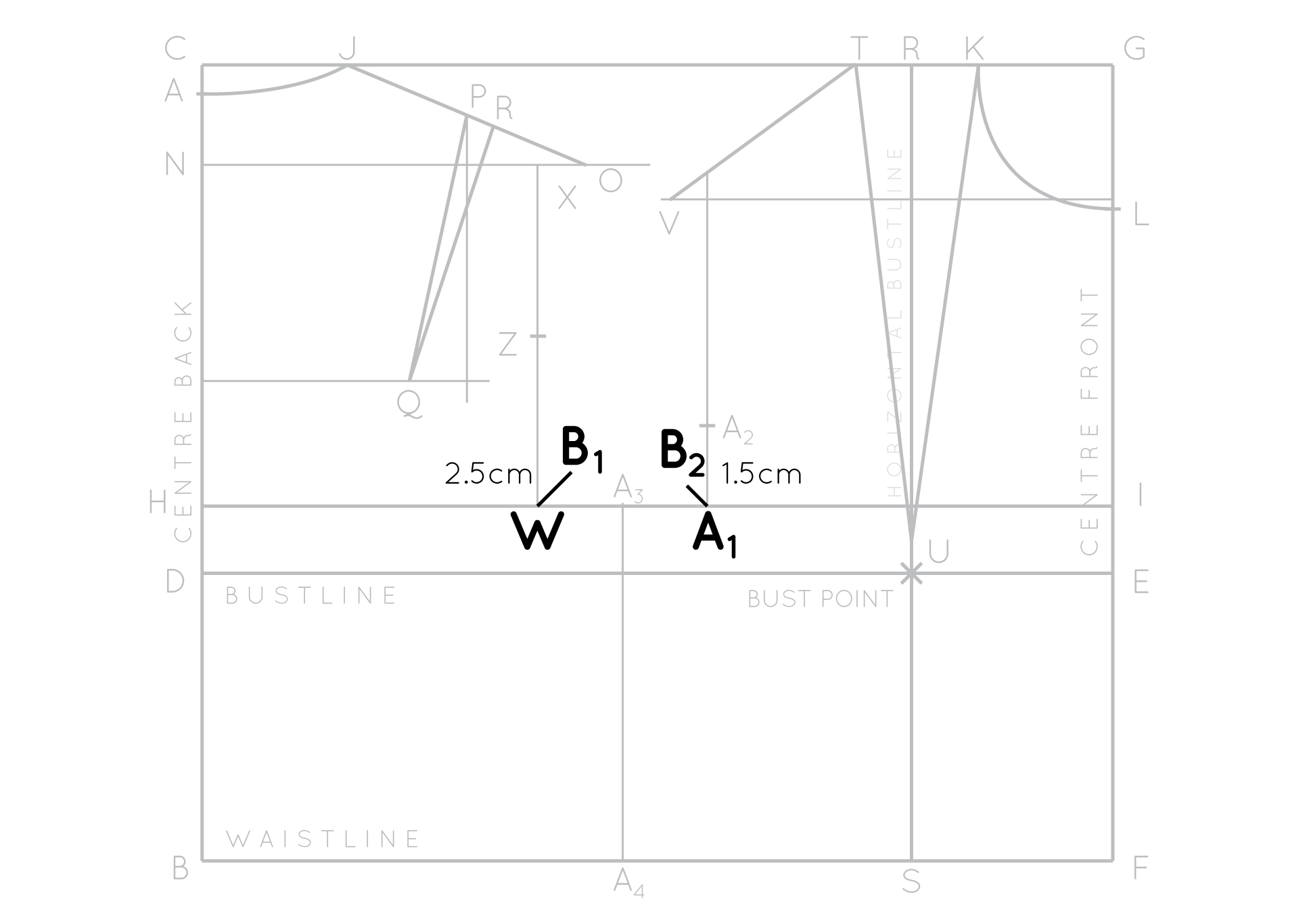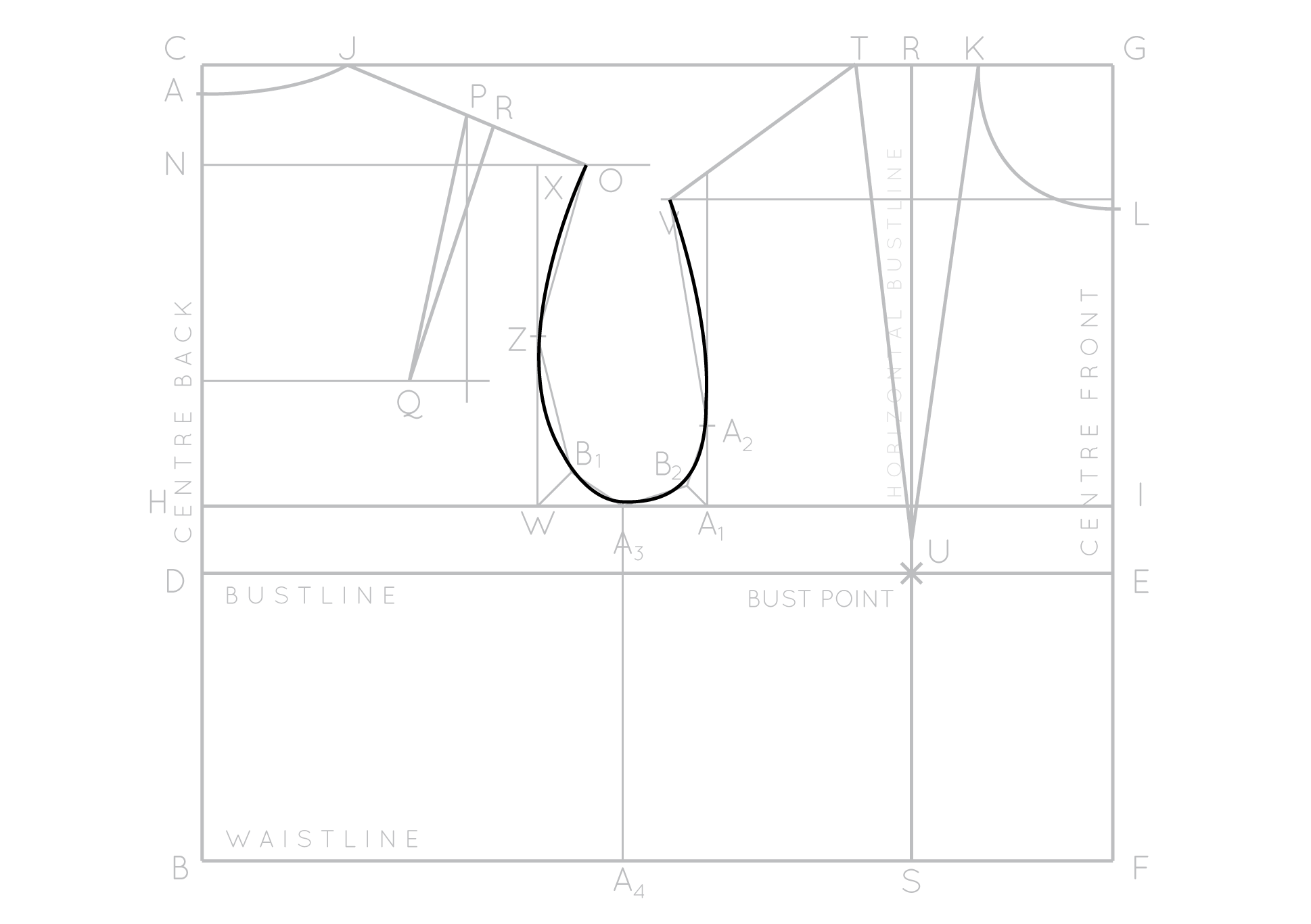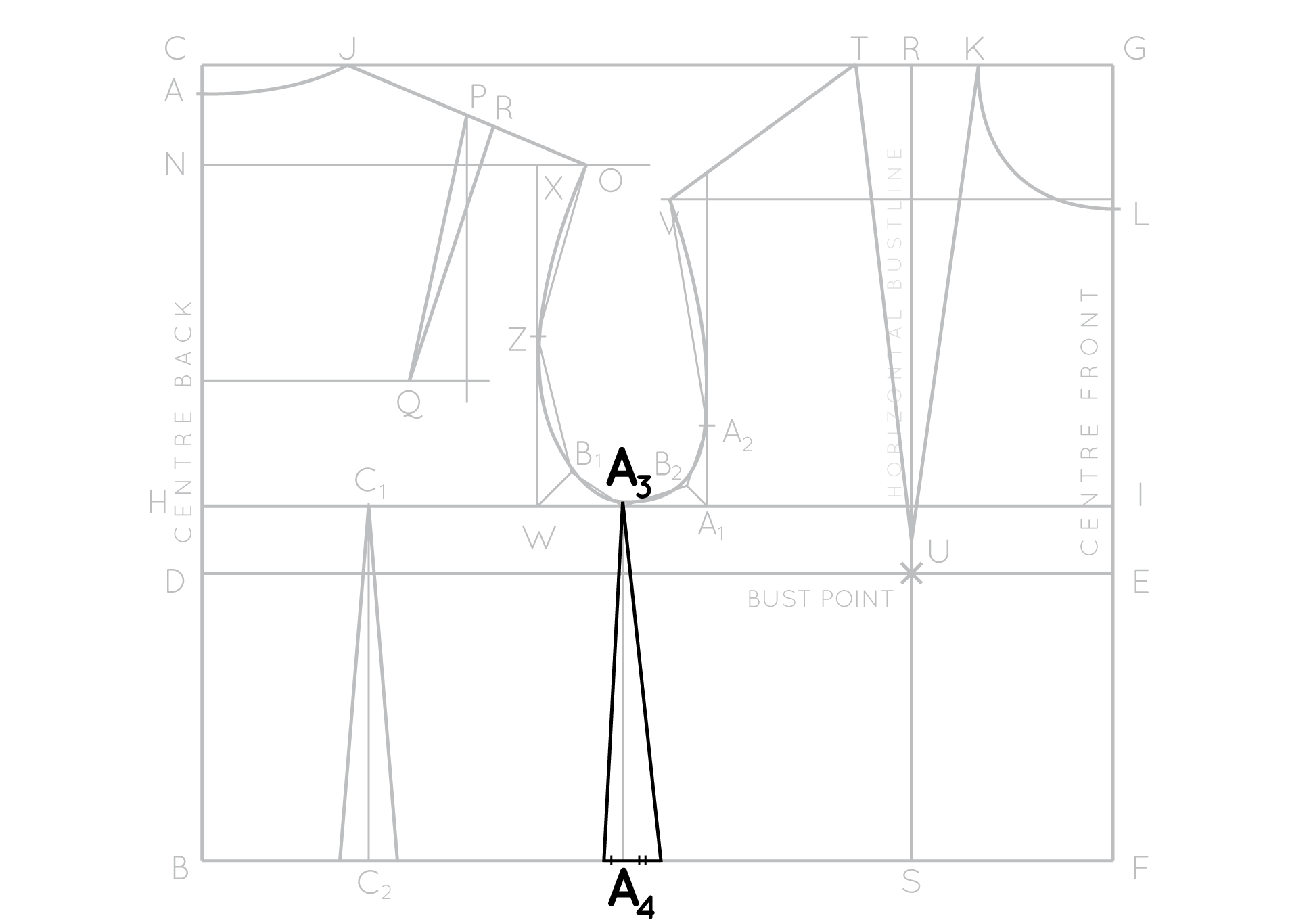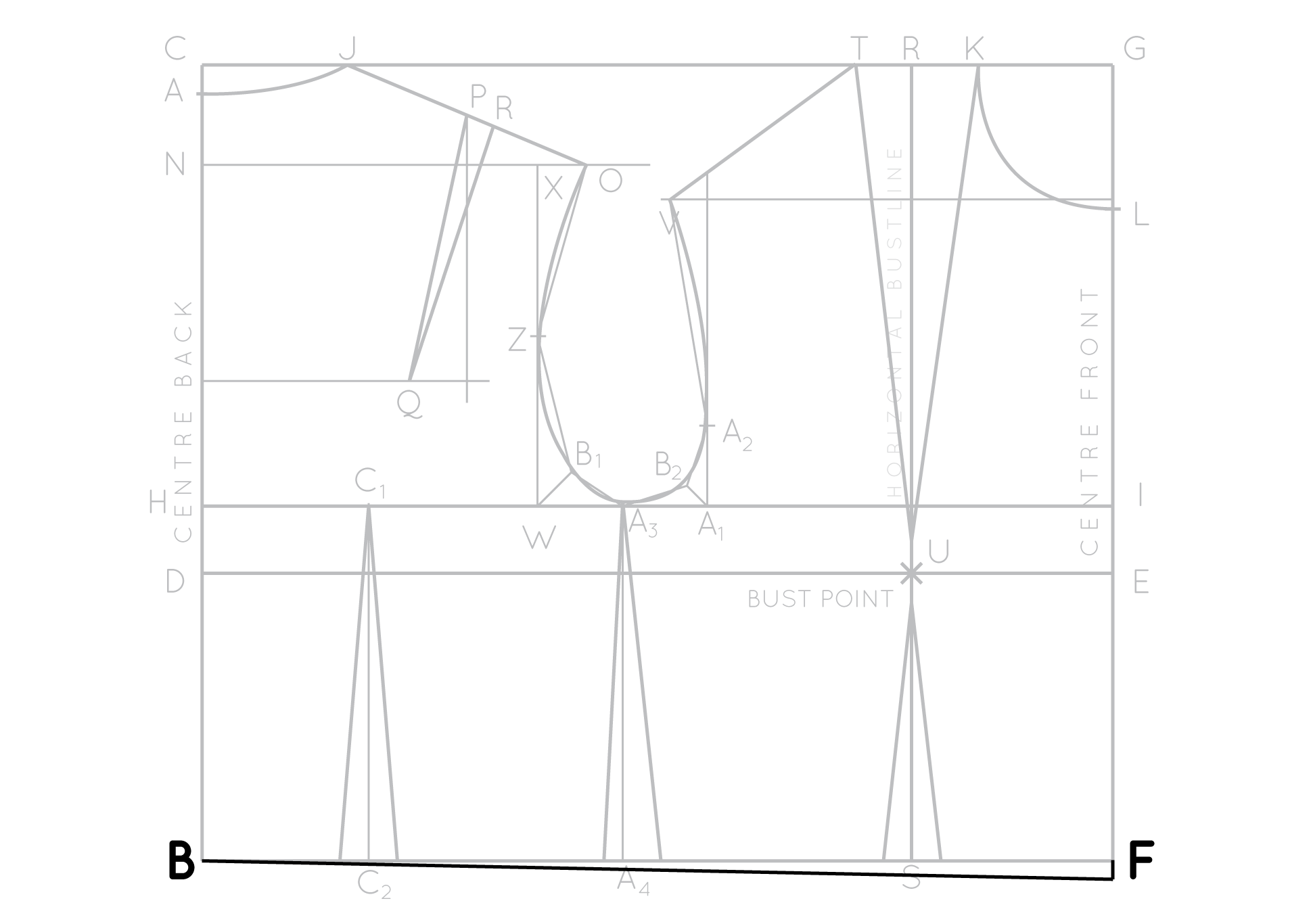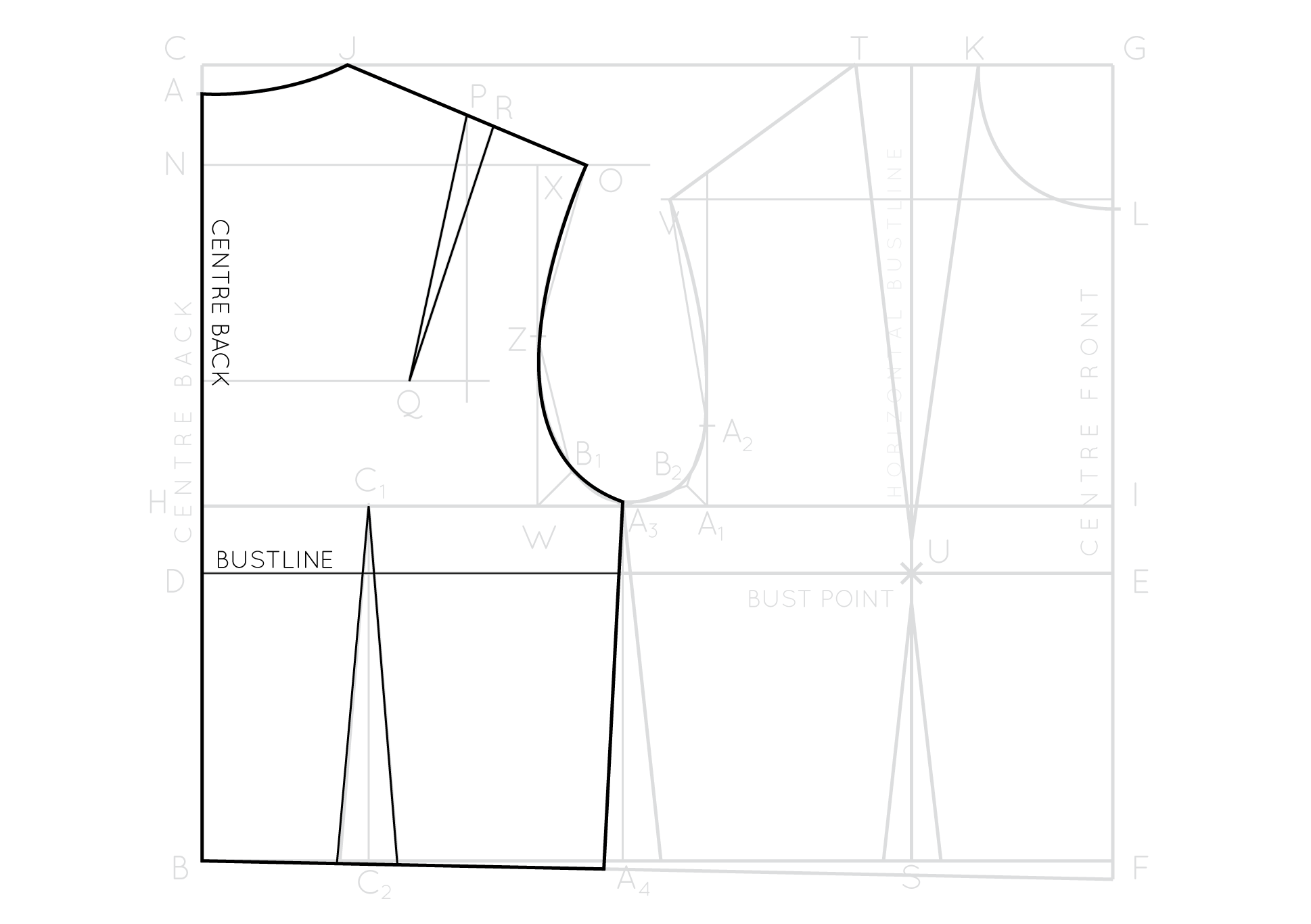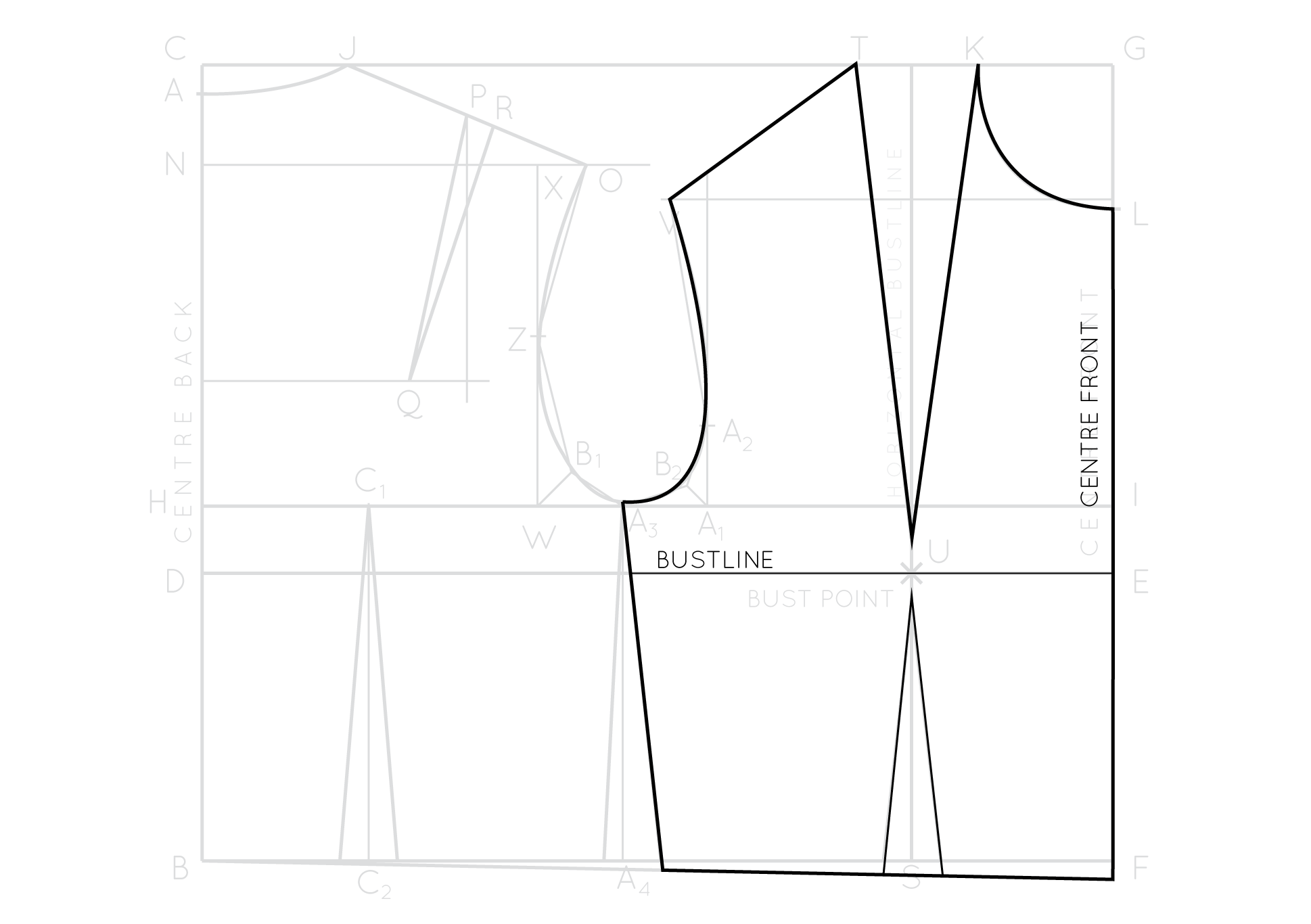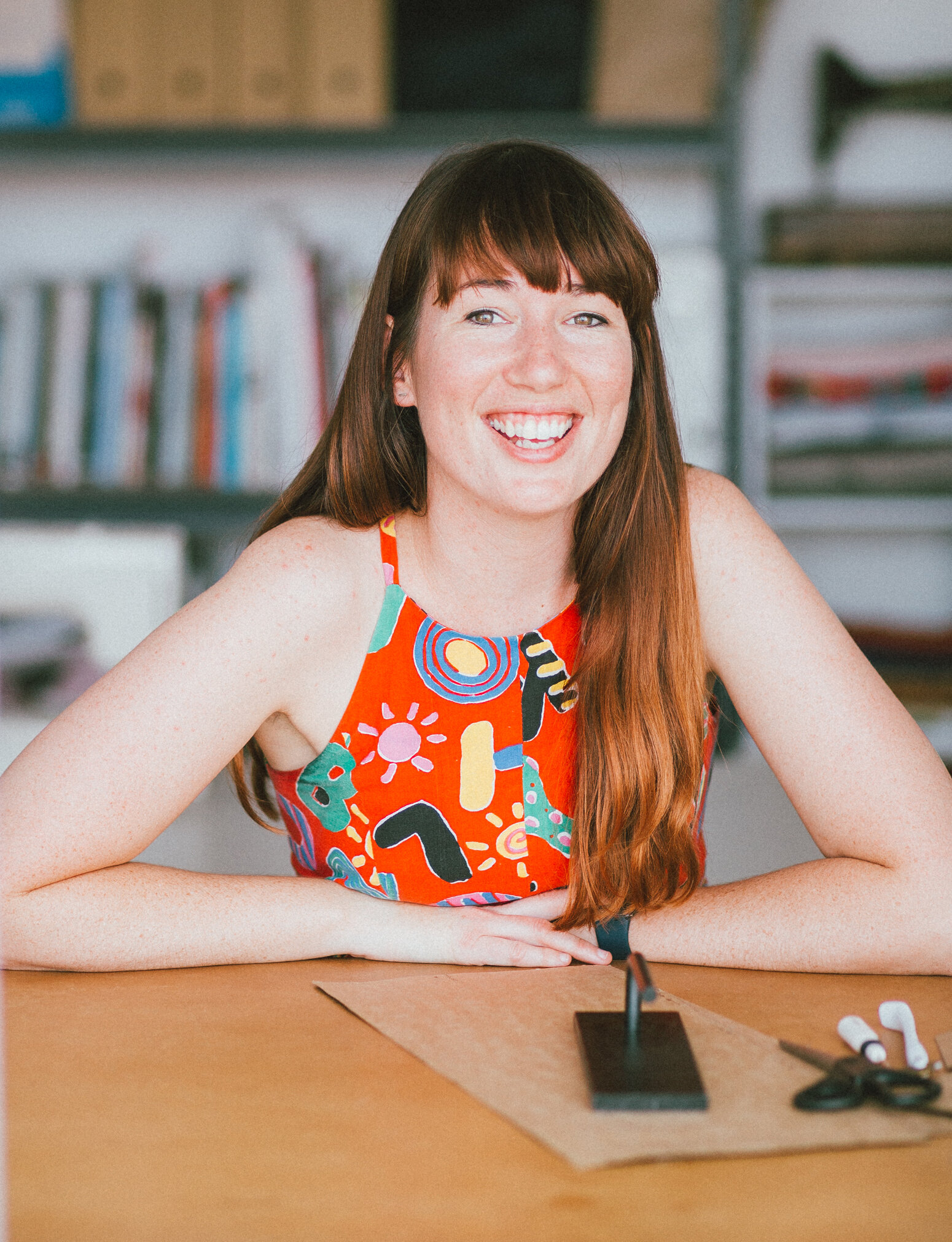After weeks and weeks (or was it months?) it is time to move on from the Skirt Series, and up to our upper halves! And also for me to get back to blogging. It has been at the top of my To-do list for weeks and weeks, but somehow I've managed to ignore it and find other things to occupy my time (for further reading on why to-do lists don't work, check out this post).
So, without any more rambling from me, it is time to draft a bodice block!
The bodice block
A basic bodice block is a great starting point for most patterns involving your top half – it can be used to make tops and dresses, and paired with a sleeve block can be used to make shirts, blazers, jackets and coats. Many patterns evolve from this block. So if you are ready to start making your own patterns, then a bodice block to your specific measurements is a great place to start (although, if you want something a little easier, I would suggest starting with the skirt block).
This tutorial has been adapted from this great "how to" on BurdaStyle.com, which was taken from Winifred Aldrich's Metric Pattern Cutting for Women's Wear (5th ed. Blackwell Publishing: Oxford, 2008, pp 215). I changed the order in places and added more measurements, to hopefully create a better fitting bodice and an easier to follow tutorial.
So, even if you are an absolute beginner, with the right measurements, the right tools and a little patience, you will have a great fitting bodice block in no time!
A little note
I originally posted this tutorial a couple of years ago, on my previous blog, Em Makes Patterns. If you saw it there, do not fret. This tutorial is the same. I've just updated the aesthetics of the tutorial. So there is no need to do it all over again!
One thing I did realise though, after posting this, is that this tutorial will only work for you if you have a smallish bust cup size. It hadn't occurred to me that this would be an issue (as I am very small busted), until a woman contacted me to say that her bodice toile had turned out much too short, and we worked out that it was due to her large bust size. So, if you have a bust size any bigger than a C or D cup, I would suggest using this tutorial to draft the basic shape of your block and then doing a full bust adjustment to get the right cup size.
Update September 2021
Thank you so much for all the enthusiasm for this blog post. It has been my most popular blog post of all time! After 5 years of answering questions, I no longer have capacity to answer individual questions regarding bodice drafting. The comments have now been switched off and I will no longer be able to get back to emails regarding this blog post. I’d suggest reading through the comments if you have a question, as it is likely I have answered a question similar to yours over the years. You can also See the post : Drafting the bodice block - Questions + Answers.
Update 2020
When I created this blog post in 2016, I had no idea that was going to become the most popular blog post on my website!
I have received a number of questions lately about the tutorial and I thought it could be a good idea to publish some of these questions and answers as an opportunity to help you on your own learning journey.
I will update the post as I receive more questions, so that hopefully, if you have a question, you will find a relevant answer here and can keep on going with your draft!
See the post : Drafting the bodice block - Questions + Answers
Measurements
The measurements you will need for this project are:
Waist measurement
Your waist is the bit in between your rib cage and your hips. It is often the most narrow point of your torso.
This measurement is one you will need all the time. To find it, simply wrap the tape measure around your waist, ensuring that the tape measure remains level all the way around (horizontal to the floor at both front and back).
Do not suck in your tummy like I accidentally did in this photo! You want to be as natural as possible, so that your clothes fit well. Make sure the tape isn't too loose, or isn't pulling you in either!
You could also tie a piece of elastic around your waist to get the right position and then measure.
Bust measurement
For your bust measurement, find the fullest point of your breasts and take a horizontal measurement from there.
Ensure the tape measure remains horizontal as it wraps around your back, for an accurate measurement (this is when measuring yourself in front of a mirror helps).
Please note: if your bust cup size is more than a C or D cup (for more info on working out your bust cup size look here), you will likely be better of making the draft as if you have a B cup bust and then doing a Full bust Adjustment.
Armscye depth
The armscye depth is the measurement I initially found the most tricky to get my head around. For one, I am quite certain I had never heard this term until I started reading sewing blogs (I don't think it was mentioned once in the four years I studied fashion design), but since then, it seems to pop up all the time (always the way, right?) It also seems that there are many different ways people suggest to find it.
When I first drafted my bodice block, I placed three fingers under my arm and then measured down from my last finger to my waist. I don't really know what the direct correlation is between this measurement and the armscye depth, but apparently, due to the ratio of the body, these two measurements are the same.
The more obvious way of finding this distance is to measure down from the nape of the neck to the (imaginary) horizontal line that runs across your back, between the bottom of your armholes.
Nape of the neck to waist
This measurement is a little tricky to take on your own. Start at the nape of your neck and measure vertically down to your waist.
The easiest way to do this is to toe a piece of elastic around your waist and have someone measure down from the nape of your neck to the elastic on your waist.
Nape of the neck to Bust line
Again, the easiest way to take this measurement will be to tie a piece of elastic around your bust and have someone measure down from the nape of your neck to the elastic.
Neck circumference
To take your neck measurement, wrap the tape measure around the base of your neck, making sure it is not too tight.
Shoulder length
To measure the length of your shoulder, first find the peak of your shoulder (this is the bony bit before your shoulder becomes your upper arm). Now measure between the base of your neck and the peak of your shoulder.
Back width
Your back width is the horizontal measurement of your back, from the bottom of a standard armhole, across to the other armhole.
Shoulder to bust measurement
For the shoulder to bust measurement, hold the tape measure in the middle of your shoulder (approximately where your bra strap sits) and measure down to bust point, following the curve of your breast.
Bust point to point
Knowing the distance between bust points (I like to call this measurement "the nip to nip") can help when adding bust darts or drawing panels that you would like to cut through the bust (princess panels, for example).
Simply take the horizontal distance between your breasts.
Tools
You will need a large sheet of paper (approximately 1m x 0.5m), a sharp pencil or pacer, a long ruler, and french curve or Patternmaster (or a plate if you don't have a french curve). An eraser will also come in handy!
Okay... Let's go!
Drafting the block
CONSTRUCT THE CENTRE BACK
With a large piece of pattern paper mark a point A close to the top left corner (always leave some space around the starting point when drafting patterns). From this point, draw a vertical line down the left hand side of the paper that is the length of the nape of neck to waist measurement. Mark the end point as B. This line will become the CENTRE BACK seam of the block and the grainline of your back pattern piece.
Extend line AB by 1.5cm (1/2") from A, and label new endpoint as C. This extra 1.5cm (1/2") allows for back neck shaping. Label AB as CENTRE BACK (CB).
CONSTRUCT the bustline
Next, we will indicate our BUST LINE (the horizontal line that runs through both the front and back of the pattern at bust level). Take the nape of neck to bustline measurement. Then, measuring from point A, mark this length as point D on line AB.
Square out from point D with a line that is half of your bust measurement (only half bust is required as we are making the pattern on the half – i.e. the front will be cut on the fold, and a pair of the back will be cut) plus ease. For the example I decided to add 5cm (2") ease to the bust. Remember to halve the amount of ease, before adding it to your half bust measurement,
Label end point of this line as E. Mark this line as BUST LINE.
CONSTRUCT THE WASITLINE
Square out from point B, drawing a line the same length as your bust line. Mark endpoint as F. Label this line WAIST LINE.
CONSTRUCT THE CENTRE FRONT
Square up from F (passing through E), the length of the CENTRE BACK (including the extension), and mark the end end point as G. Label FG as the CENTRE FRONT (CF). This will also be the grainline of your front pattern piece.
Join G to C with a straight line.
Mark the armscye
Take the armscye depth measurement and add 0.5cm (1/4"). Measuring from point A down towards point B, mark this distance on CENTRE BACK. Label this point as H.
Square out from H and extend the line until it intersects the CENTRE FRONT line. Mark the intersection point as I.
Construct the back neckline
Take your neck measurement and divide it by 5. Measuring from point C, mark this measurement on line CJ. Label this point as point J.
Join points A and J with a shallow curve – this curve is the back neckline.
*Tip
When working with curved lines, always check that they come to a right angle when they meet a straight seam (for example, the centre front, centre back or side seam). By doing this, you ensure that you will get a nice smooth curve when you cut a pair of a particular piece, or cut it on the fold.
Construct the front neckline
Take your neck measurement, divide it by 5 and then subtract 0.5cm (1/4"). Mark this measurement on line GC (measuring from point G) as point K.
On the CENTRE FRONT (GF) mark a point the same length as CJ down from point G (neck circumference divided by 5). Mark the point as L.
Join K to L with a deep curve – this is the front neckline. As we did with the back neckline, check that the curve of the neckline meets the centre front at a right angle (so that you will get a nice smooth neckline when you cut the piece on the fold).
Drafting the BACK SHOULDER SEAM
Take your armscye depth measurement and divide it by 5 and then subtract 0.5cm (1/4"). Mark this distance, measuring down from A on the CENTRE BACK as point N.
Square out from point N. This is just a guideline, so does not have to be a specific length.
Take your shoulder length measurement and add 1.5cm (1/2") (this is the allowance for the shoulder dart). With this length in mind (or written down if you have a bad memory like me), use a ruler to pivot from point J until your measurement passes through the perpendicular line drawn from N. Draw a straight line to create your shoulder line. Label the endpoint as O.
Drafting the back shoulder dart
Mark the midpoint of the back shoulder seam (line JO) (i.e. the distance halfway between J and O) as point P.
Mark a point 15cm (6") down from point A, on the CENTRE BACK line, and square out from this point. Once again, this is only a guideline, so does not need to be a specific length.
From point P, draw a guideline parallel to CENTRE BACK, extending down until it passes through the perpendicular line that you marked in the previous step.
From where these lines intersect, mark a point 3cm (1 1/4") towards the CENTRE BACK and label as point Q. Q will become the point of the back shoulder dart.
Mark a point 1.5cm (1/2") from P on the back shoulder seam (line JO), towards O. Label this point as point R.
Join P to Q to create the first dart arm, and point R to Q to create the second dart arm.
Download The Little Book of Seam Finishes
Would you like to make clothes that are as beautiful on the inside as they are on the outside?
Sign-up to the newsletter to stay in the loop to receive inspiring content that will help you become a more confident maker. And get started with a free e-book!
Mark the bust point
Move your attention to you BUST LINE (line ED). Take your bust point to point measurement and divide it by 2 (as we are working on the half) and add 0.5cm (1/4") (allocated ease). Take note of this measurement. From point E, on the bustline, mark a point, the distance you just found from point E. Mark this point as your BUST POINT.
Draw a vertical line, parallel to the centre front and centre back, passing through the bust point, intersecting all your horizontal guidelines. This line is the VERTICAL BUST LINE. Where it intersects CG label as point R and point S where it intersects the WAISTLINE (BF).
Draft the front shoulder dart
Mark a point 0.5cm (1/4") up from L on the CENTRE FRONT (line GF) and square out from this point. Again, this is just a guideline, so it doesn't have to be a specific length.
This is one of the equations taken from the BurdaStyle tutorial that is very handy (I am not sure if I would have been able to work this out without this guidance!)
Add or subtract 0.6 cm (1/4") to 7cm (2 3/4") for each 4cm (1 1/2") bust increment above or below 88cm (34 1/2"). For bigger busts you will need a larger dart (add to 7cm), and for a smaller bust you will need a small dart (therefore subtract from 7cm).
For example, my bust measurement is 84cm (33"), which is 4cm (1 1/2") below 88cm (34 1/2"), therefore I need to subtract 0.6cm (1/4") from 7cm (2 3/4"), leaving a dart width of 6.4cm (2 1/2").
Take dart width measurement and mark this distance from K as point T.
Move down to the BUST POINT and mark a point 1cm (3/8") above it on line RS (vertical bust line) as point U. This will be the point of your dart. The reason why we lift the dart point a little above the bust point is that if the dart point was right at bust point you would be left with Madonna style pointed breasts!
Join K and T to U with straight lines to create the front shoulder dart.
Drafting front shoulder seam
Take your shoulder length measurement and, with this length in mind, and using your ruler, pivot from point T until your measurement passes through the perpendicular line drawn from above point L. Draw a straight line - creating your front shoulder line. Mark the endpoint as point V.
Please note: it's not a problem if your shoulder lines overlap - just keep working through the tutorial. When you get to the end you will be tracing a copy so that you have separate front and back bodice pieces and can add seam allowance.
Drafting the armhole
On line HI mark a point that is the length of half of your back measurement plus 0.5cm (1/4”) (allocated ease), from H. Label point as W.
Square up from point W until the line intersects the perpendicular line drawn from N. Mark the intersection point as X.
Find the midpoint of line XW. Mark as point Z.
Take the distance from the CENTRE FRONT to BUST POINT (i.e length from E to BP or half bust apex to apex measurement plus 0.5cm) and mark this distance on line HI, measuring from the dart arm closest to CENTRE back. Mark point as A1.
Square up from point A1 so that the line intersects the front shoulder seam (line VT).
Take the armscye depth measurement and divide it by five. Mark this length on the line just drawn from A1, as point A2.
Find the midpoint of the line between W and A1 and mark as A3. Square down from this point so that the line intersects waistline (line BF). Mark intersection point as A4.
Draw diagonal lines (lines drawn at a 45 degree angle) inwards from points W and A1. From W the line needs to be 2.5cm long (1") (mark endpoint as B1), and from A1 1.5cm long (1/2") (mark endpoint as B2). These diagonal lines will help in the next step, when we are at the stage of drawing in the curve of the armhole.
Join O to Z to B1 to A3 to B2 to A2 to T with straight lines.
creating darts
At this point, the waist measurement is the same as the bust measurement. For a lot of us, our bust measurement is larger than our waist measurement. To remove this excess width from the waist and to create a well fitting block you will add waist darts (one in the back waist and one in the front waist – remember this is on the half so when you make your block there will be two in the back, and two in the front. We will also slightly taper the side seam, which we will also treat as a dart at this stage).
To work out how much width you will need to remove with your darts, take your waist measurement and add 2cm (7/8”) ease. Subtract this measurement from your bust measurement and divide your answer by 2.
Divide this number by three, so that it can be distributed evenly throughout back dart, front dart and side seam.
DRAFT THE BACK WAIST DART
To mark the placement of the back waist dart, find the midpoint of line HV and label as C1. Square down from this point so that line intersects the WAIST LINE (BF). Mark the point of intersection as point C2. This will become the centre of your back dart.
Distribute the dart width evenly either side of C2 and join endpoints to C1 to create dart arms.
Draft the side seam
For simplicity, at this stage, treat the side seam (line A3-A4) as a dart at this point. Distribute one third of the dart width to the back of the bodice and two-thirds to front of the bodice, either side of A2. Join the endpoints to A3 to create the front and back side seams.
Draft the front waist dart
Distribute dart width evenly either side of S and join the endpoints to a point 1cm (3/8") down from BP to create dart arms.
Balance the waistline
At this point the waistline of the pattern is straight. But as the front of our bodice must pass over the fullest part of our chest (our bust), we need to add a little extra length to our CENTRE FRONT, to prevent this part of the waistline from riding up when the bodice is made.
Mark a point 0.5cm (1/4") to 1.5cm (1/2") down from point F as point C1.
(0.5cm (1/4") for small bust / 1cm (3/8") for medium bust / 1.5cm (1/2") for large bust)
Join point B to point C1.
Trace the pattern
With a second piece of pattern paper, trace off the back pattern piece – being sure to include all important details (i.e. bust line and darts).
Leaving a space between the pieces, trace the front pattern piece.
Add seam allowance to the pattern
To finish, add shaping to the darts (following this tutorial) and then add seam allowance to the pattern. As it is a bodice block, I find that it is handy to have it available without seam allowance (as when you are making alterations or adjusting a pattern it is far easier to do so without seam allowance), but as you will need to make a toile to see how it fits, add seam allowance to the seams that will be sewn - the side seams, centre back and shoulder seams. The other seams - the neckline, armholes and waistline - can be left without seam allowance so that you can get a true indication of what it will look like without having to finish these seams or add a facing etc. I went for 1.5cm (1/2") seam allowance on the shoulders and side seams, and 2cm (7/8") on the centre back. For more details on adding seam allowance, you can take a look at this tutorial.
Add pattern markings and cutting instructions
Add pattern markings to the pattern – being sure to mark drill holes (I always mark my drill holes 1 - 1.5cm (3/8" - 1/2") above the dart point and notches.
And voila! There you have a basic bodice block to your very own measurements!
Sew it up (in calico or something similar you may have hiding in your sewing box), see how it fits and then you are ready to start getting creative making your own patterns!
Have a question about this tutorial?
Please check out these Frequently Asked Questions about the tutorial before getting in touch. I do love hearing from you, but you are likely to find your answer faster than we are able to get back to you.
Did you enjoy this tutorial?
It is our vision to empower you to make a wardrobe that you will wear, love and cherish - long into the future.
If this tutorial has helped you, it would be greatly appreciated if you could give thanks with a small donation. This will help us to continue to create content like this tutorial and continue offering it for free - so it can be accessed by all.
We greatly appreciate your support!

















